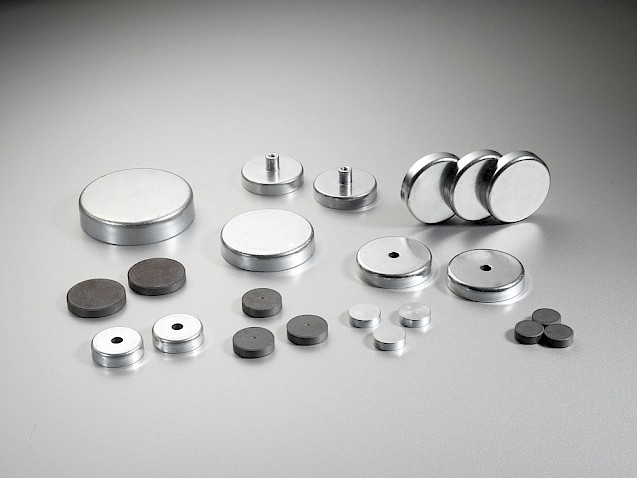Ferrite (Ceramic) Disc Magnets
Ideal for mounting and holding appliactions
Hello...
Would you like to visit the Eclipse Magnetics US site to view all relevant content for your location?

Ferrite, or also known as Ceramic, magnets are corrosion resistant - they can be used in water with no corrosion at all. Although not as powerful as Rare Earth Neodymium Magnets (NdFeB) their high coercivity and relative low cost make them ideal for use in motors and high temperature motors.
Ferrite Magnets are also termed Ceramic, Feroba Magnets and Hard Ferrite Magnets. They are one of the most widely used permanent magnet materials in the world. Ferrite magnets are a low cost magnet material perfectly suited for higher volume production runs. They are termed ceramic due to their excellent electrical insulation ability.
Ferrite magnets are superb in damp, wet or marine environments – Ferrite magnets are corrosion free. Because the iron is already in a stable oxidized form in its structure, the iron cannot oxidize (“rust”) any further when in water. Strontium Ferrite (SrO.6Fe2O3) magnets and Barium Ferrite (BaO.6Fe2O3) magnets are the two types of ceramic Ferrite magnet. The Strontium Ferrite magnets are the most commonly manufactured due to having stronger magnetic properties.
The Ferrite magnets (Ceramic magnets) have a characteristic “pencil lead” colour (i.e. a dark grey colour). They are ferrimagnetic in magnetic performance (good magnetic field and power but, size for size, not as powerful as NdFeB or SmCo). They are extremely popular in motor, generator, loudspeaker and marine designs but are found in almost all industries. e.g. Automotive, Sensor, Machines, Aerospace, Military, Advertising, Electrical/Electronic, Academic, Design House, and R&D. Ferrite magnets can be used at temperatures up to a maximum of +250 degrees C (in a few situations perhaps up to +300 degrees C). There are presently 27 grades of Ferrite Magnet available. The two main grades used today are C5 (also known as Feroba2, Fer2, Y30 and HF26/18) and C8 (also known as Feroba3, Fer3 and Y30H-1). C 5 / Y30 is a general choice of Ferrite Magnet for applications such as overband magnets. C8 / Y30H-1 is a better choice for applications such as loudspeakers and sometimes also motors (C8 has a similar Br to C5 but has a higher Hc and Hci). Ferrite magnets can be produced in many shapes and sizes. Machining to size is limited to grinding processes - the electrically insulating Ferrite material does not allow wire spark erosion. As such, the main shapes are blocks, discs, rings, arcs, and rods.
Advantages
Disadvantages

Example: A company was using NdFeB Neodymium magnets to clamp onto hot mild steel surface - the magnets were struggling to perform and cost was an issue. We supplied ferrite pot magnets which not only provided sufficient direct pull force but the pot magnets could handle the high temperatures, the magnets could not be damaged by being protected by the pot magnet design and the system was also cheaper and easy to maintain.